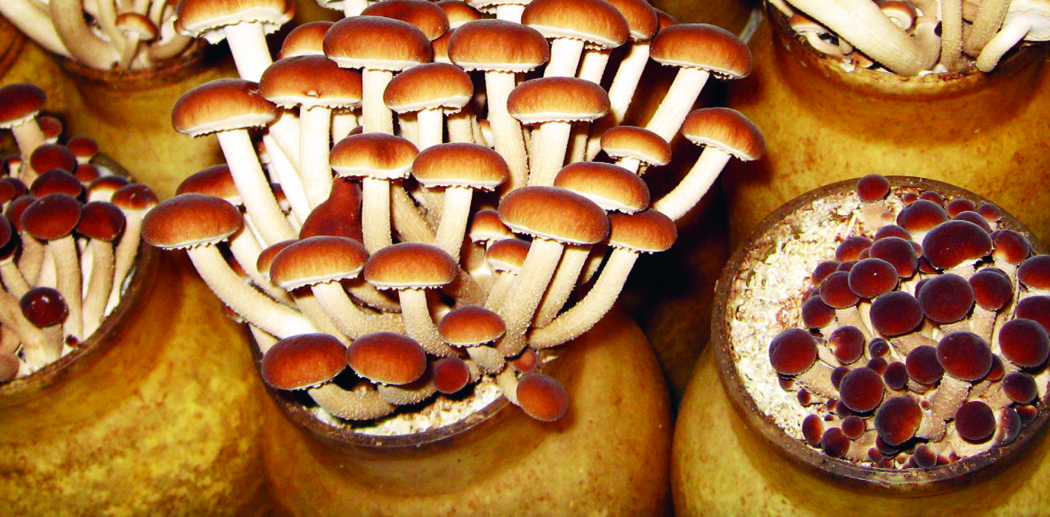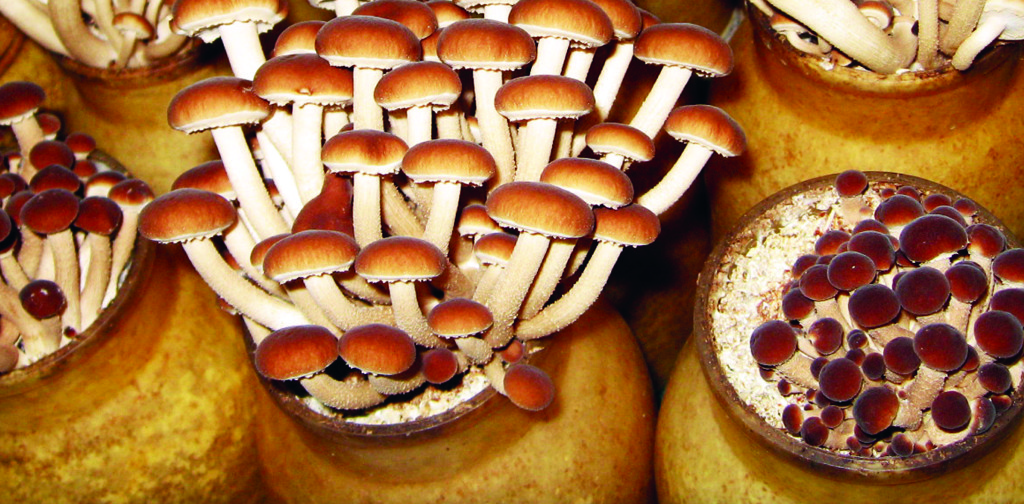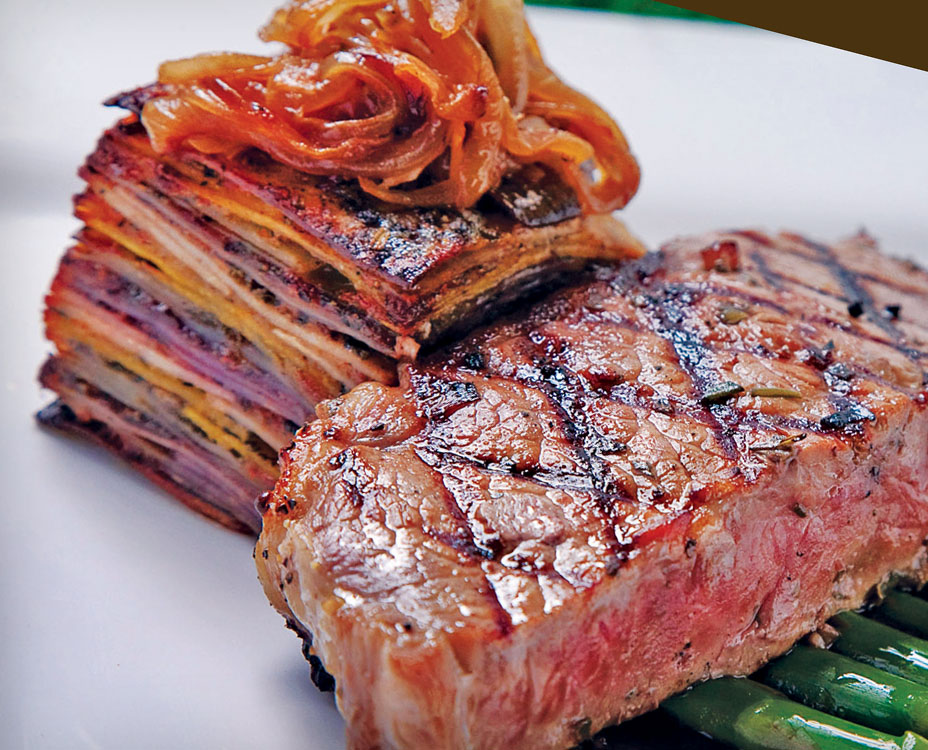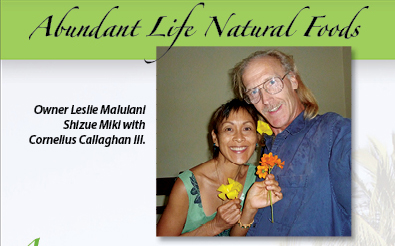
Mushroom in a Bottle: A Gourmet Fungus, from Hamakua to the White House
By Denise Laitinen
The mushroom—actually a fungus—grows on a lot of different matter in the wild, from tree logs to cow pies. It’s called “substrate,” as opposed to soil. In cultivation, the substrate makes a difference in the quality and shelf life of the end product, as we shall learn.
Janice and Bob Stanga have had their hands in a variety of careers and substrate on the road to becoming successful mushroom farmers in Hamakua.
Overcoming obstacles that would have stopped lesser souls, they persevered to create Hamakua Mushrooms, Hawai‘i’s own commercially grown gourmet mushrooms. Mushrooms from “Hawaii’s Gourmet Fungal Jungle” in Laupahoehoe are now found in supermarkets and stores around the state, on the tables of the most discerning Hawaiian restaurants, and even at a White House dinner.
Janice Stanga spent 27 years as an interior designer and her husband, Bob, was a helicopter pilot before they decided to switch careers and start growing mushrooms. Why mushrooms? Because they wanted to create gourmet items no one else was growing.
“Bob knew a lot of chefs and wanted to do something with them,” explains Janice. She had a client that grew mushrooms and “when we visited my client’s farm, it ignited our passion for growing mushrooms.”
Like many novice farmers with a passion, they found that passion alone doesn’t equal success in the business or farming world. The couple knew they needed help learning the ins and outs of farming—from the ground up—as well as the particulars of dealing with mushrooms. So they hired a consultant. Only things didn’t go according to plan.
“The consultant bailed on us,” explains Janice. Back at square one, they explored production options and discovered a growing process not widely known in the U.S.
“We use the Japanese bottle cultivation method for growing mushrooms,” says Janice. “There are very few people using this method in the United States,” she adds. “I think there are two people that I know of in the U.S. [growing mushrooms this way.]”
The growing process allows them to produce mushrooms without synthetic fertilizers, pesticides, or other chemicals. Using steam and filtration to control the growing process, Hamakua Mushrooms uses environmentally friendly techniques. The process starts with using the wood of eucalyptus trees grown in nearby forests and ends with producing a tasty mushroom, as well as spent organic matter that can be used by area landscapers and gardeners, creating a truly sustainable growing cycle.
As Janice explains it, using the Japanese bottle method is a completely different way of growing mushrooms than is commonly done with brown button or agaricus mushrooms.
“The difference between our mushrooms and other mushrooms—say brown and white button mushrooms—is that ours are wood decomposing mushrooms,” explains Janice.
She says that most types of agaricus mushrooms are composted mushrooms, grown in dark rooms using a lot of chemicals. Typically, such mushrooms have a shelf life of two to three days.
In comparison, Hamakua Mushrooms are wood-decomposing mushrooms grown in sunlit, air-conditioned rooms. If the mushrooms are refrigerated when harvested, they have a shelf life of four weeks. Hamakua Mushrooms are also grown for medicinal purposes.
When the Stangas produced their first batch of mushrooms in 2003, they started with shiitake mushrooms because that was a type most commonly known by most people. Over the years they’ve grown nameko, kea hon-shimeji (brown and white varieties), maitake, and gray cluster oyster mushroom varieties. They’re currently growing three main varieties. “Our main mushrooms now are the ali‘i, pioppini, and pepeiao” says Bob.
“We grow the pepeiao because when eight out of ten local people find out I grow mushrooms they always ask if we grow pepeiao and say they remember their aunty or uncle taking them into the forest to collect pepeiao (a word meaning “ear” in Hawaiian). It brings back a lot of fond memories for them,” says Bob.
Janice, on the other hand, is partial to the Italian pioppini mushroom, which is something they’ve recently started growing. “It’s a new mushroom for us” adds Janice. “These are really yummy, they’re my favorite.”
The entire growing process for all the mushroom varieties is done at the 16,000 square-foot production facility that sits on the Stanga’s 37-acre Hamakua Heritage Farm, the parent company of Hamakua Mushrooms. The production is done in a circular pattern, meaning that the mushrooms always move forward from one room to the next. Even the workers do not move backward from room to room because it could cause contamination within the production process.
Eucalyptus trees, harvested from a tree farm next door to their farm, are ground up to create a wood pulp substrate in which to grow the mushrooms. Personnel man the machines as the substrate is placed and tightly compacted into 1,000 millimeter jars and a hole is made in the center of the container where the mushroom spore will be placed.
“We fill the jars with substrate, a combination of wood pulp, wheat bran, corn cob, and water,” explains Bob. The jar is capped and workers clean off any loose material. The jars are then sent down the conveyor belt to the autoclave, a large pressurized tube five feet in diameter and 18 feet long. Approximately 3,072 jars go into the autoclave, which is heated to 250 degrees Fahrenheit at 15 PSI for one-and-a-half to two hours. The sterilization process kills any bacteria and prevents other organisms from competing with the spore during the growing process.
“After we’ve done ‘the cook’ as we call it, we open up the end of the autoclave that’s in the sterile laboratory,” continues Bob. “We unload all the bottles and cool them down to 90 degrees Fahrenheit.”
“Once they’ve cooled down, we run [the jars] through another conveyor belt where they go through the seeding machine. The machine, which can place 6,000 spores an hour, lifts open the cap of each bottle and places two tablespoons of sawdust spawn on top of the sterilized material in the jar,” explains Bob. “The sawdust spawn then starts to digest the substrate and begin the growing process,” he adds.
After the jars are seeded they are placed in an incubation room for five weeks and then spend another three weeks in a grow room. All total, the process from incubation to harvesting takes about two months.
Each variety of mushroom is housed in a room specifically for that mushroom and air conditioned at a precise temperature best suited for it. For instance, shiitake mushrooms wouldn’t be grown in a room with pepeiao mushrooms. “The mushrooms are particular, so each room is different,” says Janice.
The mushrooms are stacked on storage trays on racks six to seven feet tall. The size of the mushroom and the size of the grow room influence how many mushrooms can grow at any given time. For example, up to 6,000 pounds of ali‘i mushrooms can be grown in a single grow room while the pioppini mushroom grow room can only produce 400–600 pounds of mushrooms.
After three weeks in the grow room, the mushrooms are harvested. Mushrooms are picked daily to be delivered to area chefs and supermarkets.
After all the mushrooms in a given jar are picked, the remaining organic matter is recycled and made available to the public. Local landscapers, gardeners, even school garden participants are able to use the spent-wood substrate material as a growing medium. From start to finish, the process is truly cyclical and sustainable. “Nothing is wasted,” says Bob. “It’s all returned to the earth.”
Today, Hamakua Mushrooms are in supermarkets and outlets all over Hawai‘i. “Our mushrooms are with all the major food distributors in the state and on all the other islands,” says Janice. “KTA was our first supermarket account,” adds Bob. Another early vendor was Costco, a partnership that came about by happenstance.
When they were setting up the production facility, Bob and Janice bought several thousand dollars worth of storage racks from Costco in Kailua-Kona. The store manager was curious about such a large order and called them to ask why they purchased so many storage racks. When they explained that they were starting a gourmet mushroom farm, the manager was intrigued and said he’d be interested in selling their mushrooms.
Supermarkets aside, Bob and Janice early on focused on partnering with well-known Hawaiian chefs to have Hamakua Mushrooms featured in restaurants. Peter Merriman’s signature restaurant Merriman’s was the first to use Hamakua Mushrooms in its dishes.
“Today it would be hard to name a restaurant that does not use our mushrooms,” says Janice with a laugh.
Alan Wong is another preeminent chef that uses Hamakua Mushrooms. One of the 12 co-founding chefs of the Hawai‘i Regional Cuisine movement, Wong is ranked as one of the top 10 chefs in the world. In 2009, he was invited by President Obama to prepare a lū‘au meal at the White House for the first family and members of Congress. Wong served Hamakua Mushrooms at the White House. It’s a distinction few other farmers can claim. World leaders also dined on Hamakua Mushrooms prepared by Chef Wong at the recent APEC Conference in Hawai‘i.
Bob and Janice value the relationships they’ve built over the years with various world-class chefs. So much so, that they recently built a one-bedroom Chef House on the farm as a getaway retreat just for chefs. With spectacular sweeping views of the ocean, the cottage comes complete with a hot tub and an expansive, covered lanai designed for entertaining.
“It’s a place where chefs can come for a retreat away from a hectic kitchen, relax and be creative,” says Janice. The Stangas planted a wide variety of vegetables, fruits and herbs around the house so the chefs can stroll the grounds and pick whatever is in season and use it in their cooking.
The setting lends itself well to culinary events and fundraisers, and the plan is to offer events featuring different chefs. Alan Wong will be hosting the first event at the Chef House later this year. ❖
Photos by Denise Laitinen
Contact writer Denise Laitinen: wahineokekai@yahoo.com
Resources:
For more information on Hamakua Mushrooms, check out their website FungalJungle.com. It features recipes using their mushrooms, including Ali‘i Oyster mushrooms with spinach and hazelnuts, grilled mushrooms, and mushroom risotto. While the mushroom facility does not offer tours to the general public, you can view a tour on YouTube.



